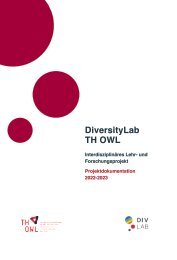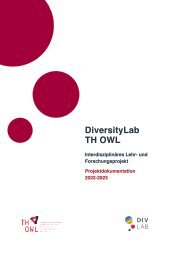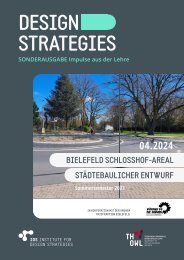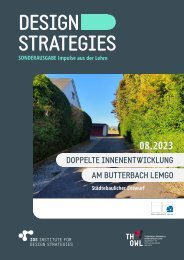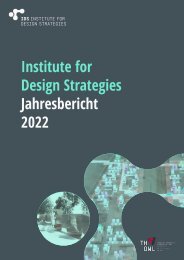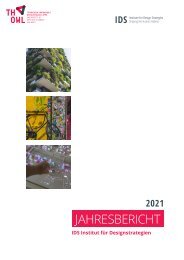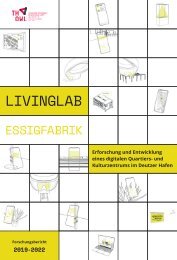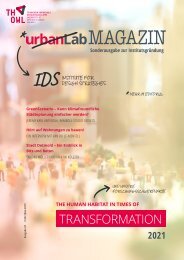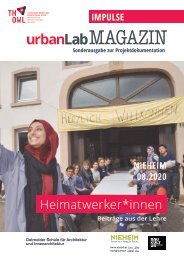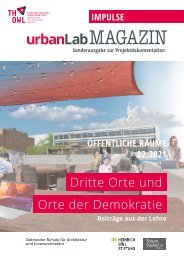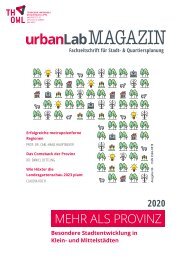Design Strategies IMPULSE - Sustainable Facades Vol 2
Report Winter Semester 2023/24
Report Winter Semester 2023/24
You also want an ePaper? Increase the reach of your titles
YUMPU automatically turns print PDFs into web optimized ePapers that Google loves.
Figure 1. Criteria of a biodegradable material<br />
Production technique<br />
Raw earth, straw, and water are combined to form<br />
the adobe bricks that make up the structure of the<br />
adobe home. These bricks are then dried in the<br />
sun after being pressed into molds. The Adobe<br />
construction style is ideal for owner-builders since<br />
no expensive tools or equipment are required, and<br />
the skills needed can be quickly gained at a training<br />
session and through hands-on experiences.<br />
<strong>Design</strong> guidelines<br />
• Orientation and room arrangement: To make<br />
use of the thermal mass of earth walls, adequate<br />
direct sunshine should be allowed to penetrate<br />
an earth structure, especially in winter.<br />
Compressed earth bricks may or may not be<br />
stabilized. However, they are usually stabilized by<br />
cement or lime. As a result, they are now known as<br />
Compressed Stabilized Earth Blocks (CSEB)<br />
Equipment<br />
Today, there are manual presses that are light or<br />
heavy, as well as motorized presses that provide<br />
compression energy via an engine. There are also<br />
mobile machines that combine a crusher and a<br />
mixer in the same equipment. The Impact 2001A<br />
CEB machine from the business AECT Earth block<br />
is seen in Figure 8. This automated machine makes<br />
300 CEBs every hour.<br />
Figure 3. Biodegradable material<br />
• Large eaves are required to protect from<br />
weather damage.<br />
Figure 2. List and category of<br />
discussed materials<br />
• In cold climates, at least the south walls are<br />
insulated. Wool insulation with cladding might<br />
be an excellent alternative since wool is a natural<br />
insulation material with low embodied energy<br />
and hygroscopic properties like earth [8].<br />
Strength:<br />
• In earthquake-prone areas, the structural<br />
design may necessitate vertical and horizontal<br />
reinforcing of earth walls.<br />
• The drying of Unfired earth products requires<br />
less energy input in comparison to fired earth<br />
brick [4].<br />
• Extremely low embodied energy (0.011-0.051<br />
MJ/kg)<br />
• Fire resistance is high (Euroclass fire testing rate<br />
A1-B2)<br />
• Products mixed with straw and other fibrous<br />
materials, usually have lots of thermal mass.<br />
• A CEB wall of 150mm thickness can be resistant<br />
to airborne sound [5].<br />
• Capable to construct self-supporting walls if<br />
their compressive strength is more than 2 MPa.<br />
Weakness:<br />
• Should not be exposed to water for a long<br />
period.<br />
• CEBs may need extra exterior wall insulation for<br />
U-value, despite their high thermal mass in cold<br />
climates [6].<br />
• Stabilizers can affect the final product’s<br />
biodegradability and recyclability, but they are<br />
needed for water resistance and compressive<br />
strength.<br />
• It is advisable to avoid using Adobe Brick for<br />
constructing houses with more than one story [7].<br />
Available products of Unfired Earth are Adobe, CEB,<br />
and 3D-printed walls.<br />
2.1 Adobe bricks<br />
Figure 4. Unfired earth (CEB)<br />
Adobe brick building is an ancient technique<br />
common in the Americas and the Middle East.<br />
In nations with high demand, adobe bricks<br />
are manufactured mechanically at industrial<br />
brickyards, or they can be made on-site by<br />
renting a brick-making machine. According to the<br />
manufacturers, the usual size of an adobe brick<br />
can be 40*20*10 cm<br />
Soil selection<br />
The soil must include between 15% and 30% clay<br />
to provide a suitable binding to the dough. When<br />
using soil with more than 30% clay, adobe brick<br />
will shrink (during sun-drying) and crack, whereas<br />
soil with less than 15% clay will disintegrate.<br />
Furthermore, it is advised that the soil be used<br />
from a depth of 50 cm, eliminating the presence of<br />
organic components such as rotting leaves, plant,<br />
and animal remnants, or roots that may interfere<br />
with the quality of the brick.<br />
• Earth constructions require stable sites. The<br />
site should not flood and, preferably, should not<br />
be exposed to strong rains.<br />
2.2 Compressed Earth Block (CEB)<br />
CEBs began in 19th-century Europe with handmade<br />
blocks. The fi rst steel press in Colombia<br />
improved upon adobe by creating denser, stronger,<br />
and more water-resistant bricks. This technique<br />
has since spread to Africa, South America, India,<br />
and South Asia with the development of advanced<br />
machinery and soil expertise.<br />
Soil selection<br />
Not every soil is ideal for earth construction,<br />
particularly CEB. Topsoil and organic soils are not<br />
permitted. The soil condition and project needs<br />
will influence the choice of a stabilizer. Cement<br />
will be preferred for sandy soils and achieving a<br />
higher strength rapidly. Lime will be utilized for<br />
particularly clayey soil; however, it will take longer<br />
to solidify and provide sturdy blocks.<br />
Production technique<br />
The raw or stabilized soil for a compressed<br />
earth block is slightly moistened before being<br />
poured into a steel press and compacted with<br />
either a manual or automated press. CEB may<br />
be compacted into a variety of forms and sizes.<br />
Figure 5. Typical reinforced adobe wall construction<br />
Figure 6. Adobe Bricks<br />
Figure 7. CEB<br />
14<br />
ARTICLES<br />
<strong>Design</strong> <strong>Strategies</strong> <strong>IMPULSE</strong> – <strong>Sustainable</strong> Façades 04.2024 <strong>Design</strong> <strong>Strategies</strong> <strong>IMPULSE</strong> – <strong>Sustainable</strong> Façades 04.2024<br />
ARTICLES<br />
15





